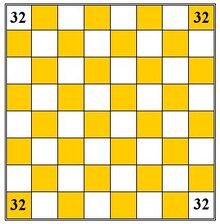| Cash in Hand |
| Inventor: Cameron Bolitho Browne, 2000 |
| Ranks: Eight by Eight |
| Sowing: Single laps |
| Region: Australia |
Cash in Hand was designed in 2000 by Cameron Bolitho Browne (Australia). It is a two-dimensional sowing game for two players. The game is flawed because each player can easily create a position, which guarantees a draw.
Browne is an Australian researcher into AI, board games and graphics. His favourite sports are squash, tennis, and racquetball. His greatest sporting achievement was being the #1 squash player in the University of Queensland college competition in 1990. He also loves motorbikes and sailing.
Rules

Initial Position
The game is played on a chessboard (i.e. 8x8 checkered squares).
At the start of the game, a player has 32 stones on each of his corner squares (either black or white). The counters, which do not need to be stackable, are all of the same color. A total of 128 is needed to play the game.
The player called "White" plays on the light squares, while his opponent called "Black" only uses the dark squares.
White starts.
At each turn a player distributes ("sows") any number of stones from one of his occupied squares, leaving at least one stone on every square he passes along a diagonal path of adjacent squares of his color.
- He may change the direction after each square.
- He is not permitted to visit a square twice or return to the square, from where he started.
- He isn't allowed to go to a square, which contains more stones than he has still in hand (his "cash in hand").
- He may not sow between two squares that are occupied by his opponent with more stones than he has still "cash in hand".
After the sowing has ended, the player captures the contents of all those enemy squares, which are completely surrounded on all orthogonal sides by occupied squares, if the enemy square has less stones than the surrounding squares. The corner squares have two orthogonally adjacent squares, the edge squares have three and the center squares four.
Captured stones are re-entered in the same turn by adding them to any occupied squares (of either color!). This doesn't result, however, not in more captures so that the opponent may rescue any threatened stones in the following move.
The player who has lost all of his stones, also loses the game.
Drawing Strategy
In order to secure a draw, a player must move the 32 stones from one of his corner squares to the opposite quarter of the board without splitting them. After he has merged all his 64 stones, his opponent can no longer threaten capture of his stones.
External Links
Copyright
© Ralf Gering
Under the CC by-sa 2.5 license.